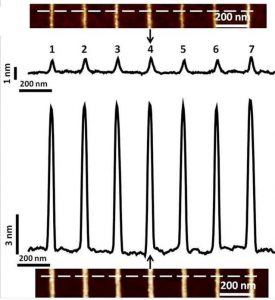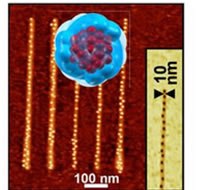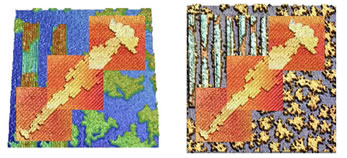1. Template growth
The nanoscale silicon dioxide structures fabricated by oxidation scanning probe lithography (o-SPL) can be used as templates to form ordered molecular structures of variable size ranging from nanometers up to micrometers. The template growth of organic and biological molecules is achieved by physical, chemical or a combination of both methods. The electrostatic interactions between the nanostructures and the molecules can be tuned during the nanofabrication process. By this way, the interaction can be modulated to achieve the desired selectivity. Additionally we explore different chemical approaches for the functionalization of the nanostructures and the molecules of interest.
2. Etching masks
The small silicon dioxide structures fabricated by o-SPL can also be used as etching hard masks to produce SiNWs after pattern transfer by reactive ion etching.

Fig 3. Silicon oxide mask for pattern transfer (upper row) and the produced silicon nanowires (lower row) after dry etching
Relevant publications:
- Y. K. Ryu, P. A. Postigo, F. Garcia, and R. Garcia, Applied Physics Letters, 104, 223112 (2014)
- Ricardo García, Marta Tello, Jean Francois Moulin and Fabio Biscarini,
Nano Letters 4, 1115 (2004) - R.V.Martínez, J. Martínez, M. Chiesa, R. Garcia, E. Coronado, E. Pinilla-Cienfuegos and S. Tatay, Adv. Mater 22, 588 (2010)














